Around this time of year, coming up to Beltane, you’ll see articles about the Maypole and dancing thereat. Usually there will be some mention, unsupported by any evidence, of Maypole Dancing as an ‘ancient fertility rite’. Victorian folklorists loved this particular fancy. In reality, what we generally think of as ‘Maypole Dancing’ is more of a ‘chastity rite’. This dance style was created by Victorian Sunday-school teachers. The dances are usually performed by pre-pubescent children, all dressed in ‘pure’ white, and they never touch one another!
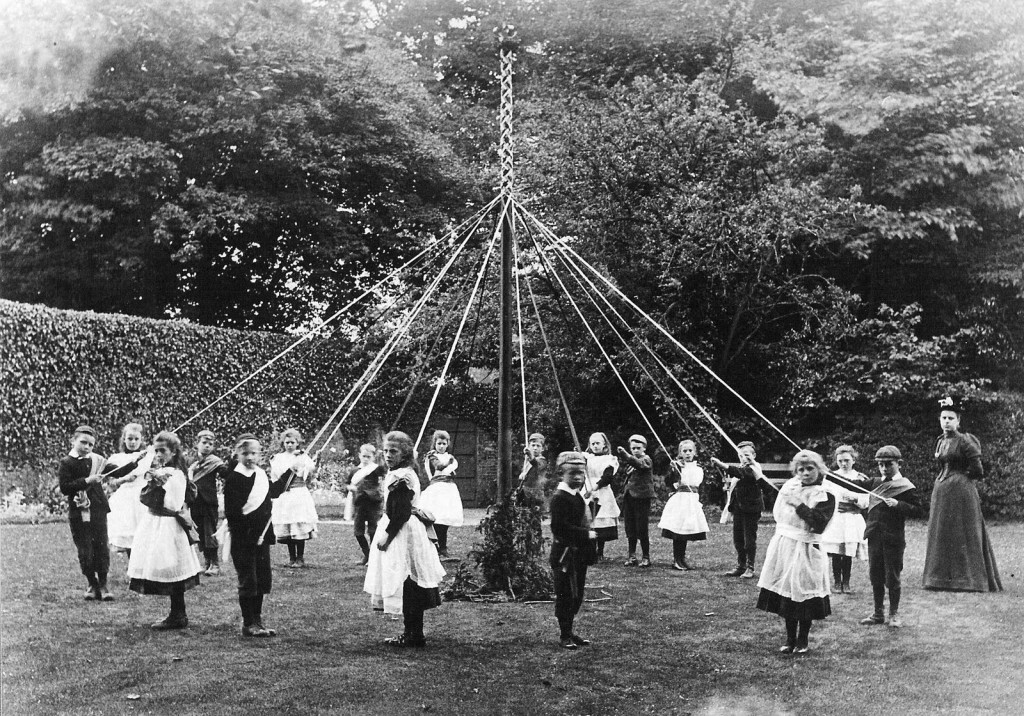
Spring is certainly doing its thing at this time of year, and humankind cannot help but respond. April can be the cruelest month for the unattached. The chance of a festival and a celebration after winter’s cold has passed and travel has become easier puts a sparkle in the eye even of the aged. ‘Fertility’ is of course the Victorian Christian folklorists’ euphemism for sexuality. But as Pagans rediscovering our spiritual connection, we are ill-advised to let the Vcfs define it for us. An interesting recent article by Sorita d’Este – http://www.patheos.com/blogs/adamantinemuse/2018/04/beltane-hekate-goddess-of-the-sacred-pole/ links the Goddess Hekate to the Maypole, concluding:
So perhaps, it is time to put aside the assertion that poles are always phallic symbols, representing the male genitalia and the Masculine Divine. It might seem obvious to us today, but the pole is also a symbol of the Divine Feminine, around which devotion to her centred – and perhaps, still does.
For me, the Maypole is not at all a phallus of the Vcf fantasy, but simply the World Tree. It’s not a ‘symbol’ (or any other weasel word of denying). Every Maypole is the World Tree. The ribbons are the threads of Wyrd that we weave in our lives. In our dance, we have the special opportunity to unweave them free of all tangles and do it all again. Real life tends to get things into knots that only the Shears of Atropos can resolve.
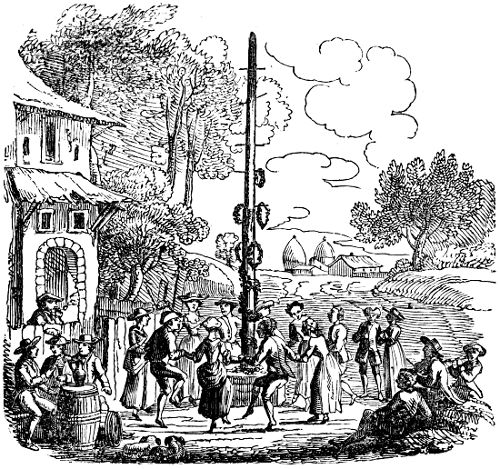
I fell in love with Maypoling back in 1995, at a Circle Dance teachers gathering, when one of us brought a homemade minipole and taught an authentic Greek Maypole dance – some claim the tradition originated in southern Europe. It intrigued me that despite being very skilled dancers, in fact quite a few really struggled to do Maypoling at all. I was inspired to make my own Maypole, which I hawk around anyone who will have me at this season. Folk generally do enjoy Maypoling even when making the most appalling mess of the ribbons, just like life itself perhaps. Nonetheless, seems to me that if it’s fun to do it wrong, it has to be lots more fun to do it right, to dance perfectly in the groove. Done right, one can keep plaiting and un-plaiting again and again, until the musicians play their time-to-go-to-bed tune.
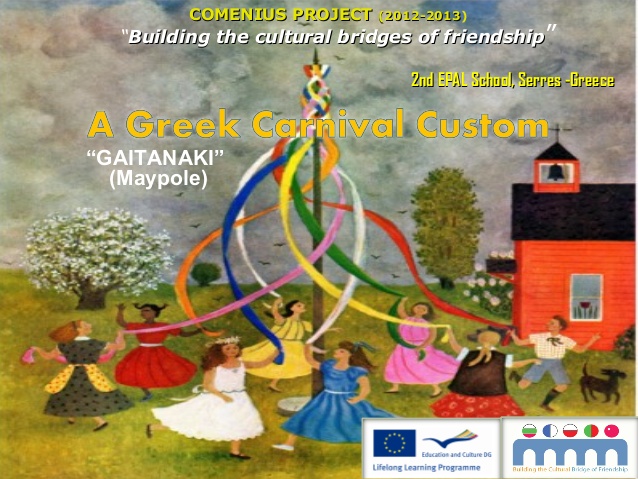
I’m hoping that potential Maypolers will be interested in my efforts to ‘get it right’, especially anyone mug enough to try to teach Maypoling to a group. If you would like any more explanation of rhythms or step sequences just put a response on the blog page.
It’s not so difficult to create a portable Maypole. ( Skip this next bit if you wish! Pass on to carpentry-competent friend.) The pole itself is a piece of dowel, thickest you can get, eg from B&Q – will be maybe 2.4 metres, 3 metres if you’re lucky – celings are more than this in most dance rooms, but not always so at home. Needs to fit into your vehicle… I prettied the pole with two rolls of sticky insulation tape, red and yellow, spiraled all the way down. The top part was a piece of 150cm wide timber, cut square then the corners chopped off to make an octagon. Two holes drilled each side to hold 16 ribbons in all. If you can go for something large, 24 is perhaps the maximum. (Larger numbers than that can dance two persons to a ribbon.) You need a minimum of 8 people to do any of the dances. The top is held on to the pole with a detachable screw, with washers so it rotates freely. Then you need a socket. First I drilled a hole to match the pole in a solid block of timber (eg 10cm * 10 cm). Then screwed that with no. 10 screws to a much larger square board (again trimmed to make a pretty octagon. This is ok for most folk. With really incompetent dancers a breeze block, or a patient child, on the board helps it not to move. A bright cloth, hole cut in the centre to fit the pole, serves to hide these practicalities.
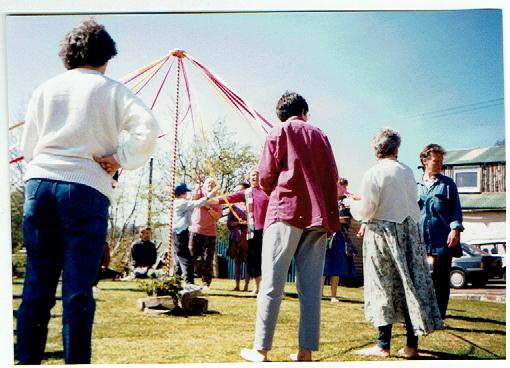
You need much longer ribbons than you might imagine, because of course some of their length is taken up in the plaiting. For a 2.4m pole, you need at least 4m each ribbon, 5m better. Proportionately longer for a 3m pole. This is the most expensive bit of the creation. I chose ribbons in just two colours, red and yellow, so as to assist, I hoped, in the dancers’ role understanding.
Unfortunately, you can’t practice on your own in the kitchen… you just have to have an adequate number of enthusiastically consenting friends. There are basically two types of Maypole ‘plaiting’ dances, though of course you could also dance freely, around, in and out without ribbon tangling. The ‘inside trace’ or ‘closed trace’ dances plait the ribbons down the pole. The ‘outside’ or ‘open plait’ dances create various spiderwebby patterns until you run out of ribbon.
When you see kiddies dancing, you have to realise they will have been drilled mercilessly by Teacher for a couple of months previously. I’ve always danced with motley crowds of adults, many of them ribbon virgins, generally with ideas or preconceptions of their own. That makes things a bit more unpredictable. People always do seem to enjoy it, even when, not infrequently, they make a dog’s breakfast of the actual plaiting. There are three basic Rules in Maypole Dancing: (i) Don’t let Go (ii) No Stopping (iii) No Overtaking. Most folk do what you tell them, best as they can, but there seem to be several types who complicate things. The Ditherers violate the No Stopping rule, causing a traffic jam much like a random stopped vehicle on the M6. The Maenads violate the No Overtaking rule, merrily skipping through others like a motorbike in a traffic jam, turning the ribbons into an ‘impenetrable string tangle’. It’s a very tedious and slow business to unwind a plaited set of ribbons by oneself. The trick is simply to reverse the dance, unwinding back to start – but this has to cope with previous ‘mistakes’ and there’s usually at least one person, the Rebel, who thinks they should take charge, violating the Don’t let Go rule at this point, attempting to untwine ribbons by hand instead of dancing! Then of course there’s the Loving Parent, who fondly imagines they can Maypole effectively whilst holding hands with a toddler.
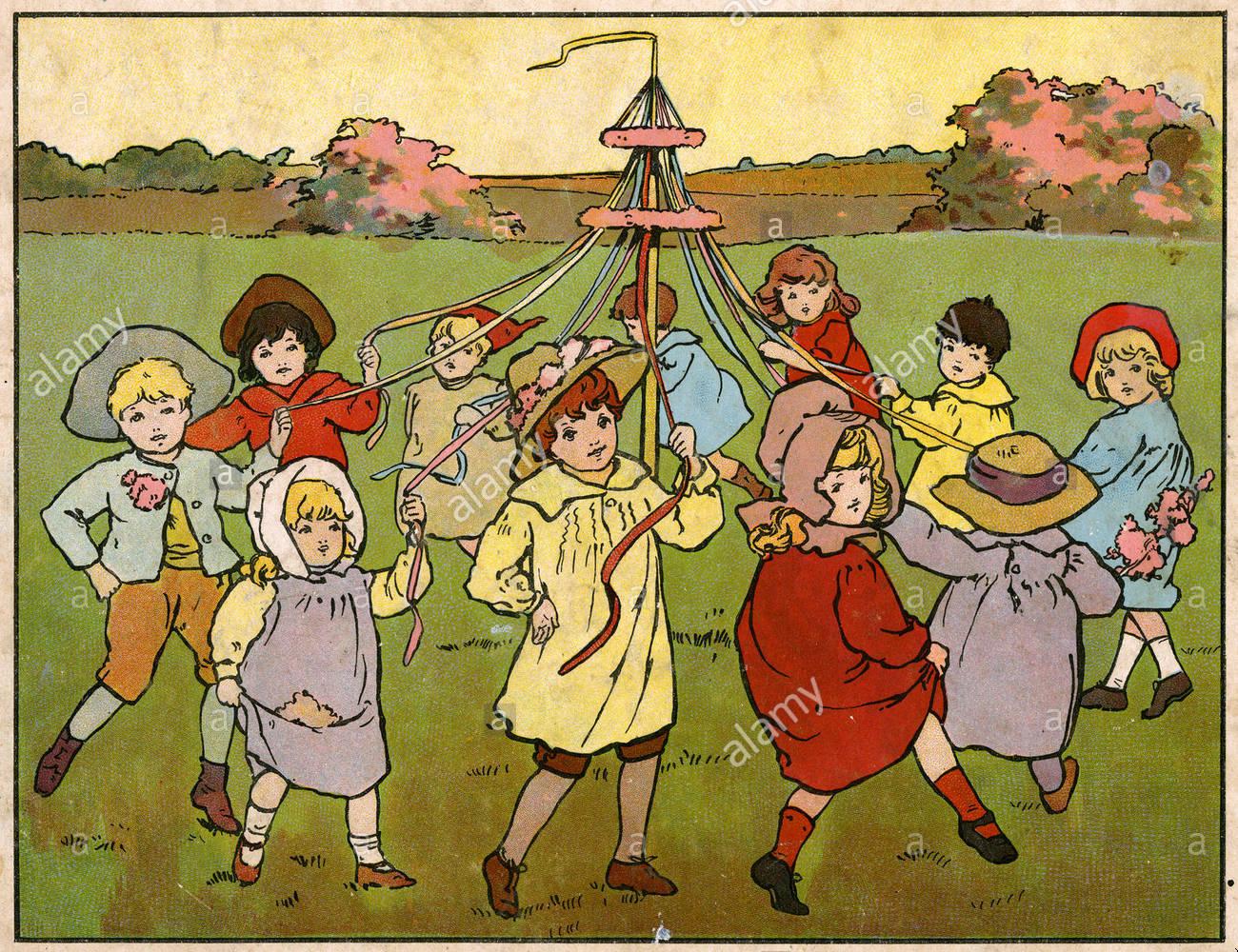
A Maypole Revelation came to me one day, on the Parrog at Newport as it happens, as to why it is that otherwise perfectly competent adults, and even expert dancers, have such difficulty with the whole thing. What happened was that random dragged-in folk (including men!) made a perfect job of a supposedly ‘advanced’ dance, but a mess of the supposedly ‘basic’. How could this be? Terpsichore kindly explained the paradox to me, and so I’ll share it with you.
The ‘advanced’ dance was the ‘Test Valley Tangle’ – a variety of open plait. Goes like this:
- Dancers start in pairs standing back to back – one colour facing deosil (clockwise), other colour widdershins (anticlockwise). All take four steps LRLR so as to meet the person they are facing from next ‘spoke’ of the ribbons.
- Dancers make a ‘pas de bas’, ie quick diddly-dum 123 to their own left and right
- Dancers take 8 steps to circle each other clockwise – starting L – the first 6 steps actually are enough to being them once again face-to-face and the last two then take them further around into back-to-back arrangement, after which all happens again.
- Unplaiting works much the same, except to start with R variously, and to circle each other anticlockwise.
I’ve been using the tune ‘Bondepigen’ for this – more traditionally a pleasant dance for threesomes. The Maypole sequence above takes 8 bars in 2/4 time. The version I have is just about the right duration to use up my ribbon length. Sample below is by ‘Sants and Fot’, their album ‘Quins Anys’ – purchasable I think from : http://santsandfot.trad.org/
Now according to Terpsichore, there are two things that make this dance ‘work’ even with the uninitiated:
- The steps are ‘structured’, everyone doing more or less the same thing, more or less in time with the music, as indeed happens in Circle Dance generally.
- The dance proceeds as a series of ‘encounters’ (eye-contact essential but flirtation optional). Each encounter resets to an easily comprehensible standard configuration and thereby re-synchronises those who struggle to match their own steps to rhythm.
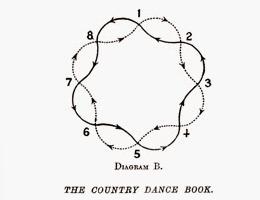
When one compares this with the ‘basic’ dance, used for a single closed trace, both features are missing. Dancers are advised to do a sort of ‘grand chain’, passing others alternately by right and left, as per pattern shown her for eight dancers. But whereas a ‘grand chain’ in ‘country dance’ involves an ‘encounter’, taking hands alternately R and L with each new partner, when Maypoling, hands are occupied with the ribbons, and in fact dancers are avoiding any contact with each other. Furthermore, whereas the contact in a grand chain serves to swing both in a direction for the next encounter, when Maypoling each dancer has to make a freestyle turn in order to re-position. For the Ditherers, the free rotation is deeply disorienting – they stop, not knowing where to go next. A traffic jam occurs, and the buildup can bend or tip the pole, whilst the Maenads just frolic on past regardless !
As to specific (structured) dance steps, it is rare that these are advised at all. Generally, those playing ‘Music for Maypole Dance’ play jigs (6/8 time) at a vigorous tempo, and dancers are told to ‘skip’. Technically, a ‘skip’ takes one bar of 6/8, steps timed medium / quick / slow, utilising 2 / 1 / 3 of the quaver notes. On average, even well-trained kiddies, especially nowadays, will be puffed after about 90 seconds of this exercise, which perhaps matches the parental attention-span. So that’s about as long as they dance for, then unwind similarly after a breather.
The concept is hopeless for adults. Firstly, as a rule they can’t skip at all, especially at the expected tempo. After a couple of attempts at such they degenerate into a Maypole Walk. The 6/8 rhythm is also often used as ‘marching time’, but of course, the idea of a Maypole March feels inappropriate (especially for Maenads) and so almost immediately the dancers will be wholly out-of-step with one another. Any hope of synchronisation flies away – the Ditherers do so all the more, and the Maenads dance to their inner music instead. Traffic jams ensue, with all dancers on one side of the Pole, which can bend alarmingly. As yet I haven’t suffered the dreadful omen of a Broken Pole! Additionally, it seems to me that for adults, as with that most popular of activities, most prefer to not to charge maximum speed at things, but to go more steadily, with the experience lasting rather longer than 90 seconds.
The challenge then, was to find a way of dancing and teaching the dances, especially the ‘basic’ single trace, so as to establish ‘structure’ and ‘encounter’, synchronising the dancers, and actually having them dance to the music, not just amble (or plod) to accompaniment.
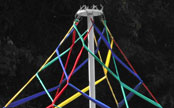
For open-trace dances, it’s fairly easy to introduce a structured step sequence. For example, in “Spider’s Web”, half the dancers are static. Once can use a ‘Setnja’ sequence for this – (S,S,Q,Q,S, each sequences alternates starting foot) first sequence to travel to next dancer, one sequence on the spot , one to move to back of static person and one to move back to outer dance track. For adults, you need to swap roles every couple of encounters to avoid boredom.
I’ve tried a few possibilities – unfortunately there’s no single, simple answer. In reality, one does not always have a full complement of dancers – one can easily have as few as 8. Sometimes one is called to dance at larger-scale poles with 24 or even more ribbons. What this means in practice is that both the linear distance and the angle between pairs of dancers is not at all consistent. If folk have erected a pole of traditional dimensions, 6 metres or more high, the inter-encounter distance takes a lot more steps to cover. The dancers too have their own character, so each Circle of dancers is a new experience, not necessarily matching what others have done!
The most fundamental thing has to be to slow things down, or rather, to take more steps between ribbons than the standard expectation. It isn’t always easy to win the Maenads over to this idea, and they can get a bit grumpy. If you have real live musicians, typically they are not themselves dancers, and they often prefer to play like the clappers. They need restraint, confiscate their bottles. They have to play each tune rather longer than they thought (buy them a drink afterwards). With recorded music, the usual cd of ‘Maypole tunes’ is a disaster. It’s easy to think one should ‘keep it simple’, but actually this is a trap that promotes the Plod. For example, if you fancied dancing to the wonderful ‘Staines Morris’ song, you might think it would be ok to step 1-2-3 hop to each bar/measure of the music, and that this would be enough to pass each ribbon. But no, people actually take smaller steps than usual in the Maypoling context, fail to reach next person in these steps, fail to hop, and generally degenerate into asynchronous amble. It actually needs a combination of long and short (timed) steps, including deliberate ‘stops’ and explicit changes of direction. The sequence described above for the Test Valley Tangle has all these, but far from requiring ‘advanced’ dancers, is fully within the capability of all but the hopelessly dischorate. But do be aware though, children don’t usually cope with any sort of ‘structured dance’ before the age of eight at least, maybe to do with the development of more abstract numeracy. (Little ones are best managed just to skip around, all in the same direction, as per illustration above)
Sample of ‘Staines Morris’ from ‘Morris On’, sung by Shirley Collins. https://www.amazon.co.uk/Thompson-Mattacks-Kirkpatrick-Dransfield-Hutchings/dp/B00006OYLQ/ . You can use the ‘schottische’ steps with this music.
it isn’t always easy to find suitable recorded music. A track needs to be a minimum of three minutes, preferably somewhat longer. And the same again to unwind of course (this can take a little longer than the initial plait.) Music that wasn’t explicitly created for dancers often has a ‘middle 8’ that doesn’t have the same phrasing as the rest – beware! Dancers will need to know this advance, so they can have a breather, maybe dancing a couple of extra sideways sways at the encounter. I love dancing to the Swalcliffe May Carol, as performed by Magpie Lane – but it’s easy to be thrown off by the ‘break’ halfway through.
If your music is in 4/4 time, then there are a couple of simple options. Firstly you could try the ‘Setnja’ sequence – slow, slow, quick, quick slow. many tunes can readily fit to this. (A Setnja sample and source is on my ‘Daffodil Dragon Day’ post.) Use two sequences for each ribbon. The first should be sufficient to bring the dancers into proximity of new encounter – the second sequence can be danced on the spot if necessary, making eye contact (with flirtation potential), and to achieve the necessary change of direction before moving off to next. An alternative, possibly better (less prone to degeneration into plod) is the Schottische sequence, which also fits many tunes typed as ‘reels’. For this, do a quick-quick-slow (a sort of shuffle, small steps) first to left, then to right, followed by four slow steps. In a tight configuration, one sequence may be enough for each encounter, with the slow steps used for synchronisation and rotation. In a larger or looser setup, use two sequences per ribbon.
You can Maypole to almost any traditional music. In waltz time, you should think in terms of 4 bars per encounter – dance two bars traveling as quick waltz steps (123, 123) then two bars simply on the spot, perhaps just a sway each side. The Greek Maypole dance that I learnt so long ago uses a Syrtos rhythm (slow-quick quick, repeatedIy). I found the original just too fast a tempo, and slowed it physically by 10% (this is easy with the free software Audacity). Even so, this can be a bit brisk for freestyle, compared with dancing in a hand-holding open circle. You can introduce a pause by doing two SQQ sequences to travel (usually R-LR, L-RL) , but for the encounter, simply step (R) to side, then touch ground with L foot, and likewise step L, touch R. If you are compelled to use a jig, then you can slow things down with a ‘slow skip’ – slow, slow, skip-y-step when travelling, or for encounter / on-the-spot, touch heel and toe for the slow bar. This then takes 4 bars per ribbon
Sample of ‘Samokovsko Oro’ – rhythm has a half-beat pause on each fourth beat. This version slowed down a bit from the original by Rasalila on the ‘Free Range’ album. (Available from me.)
I’ve also tried to rethink the topology a bit. A grand chain isn’t actually necessary for a single closed trace. An alternative, topologically equivalent, is to dance in two parallel tracks, like a kiddies’ circular railway. One step sequence moves on the track to next encounter, the second sequence crosses tracks passing back-to-back. For this, I had a go with music unexpected by the dancers – a 9/8 rhythm as in the Balkan Samokovsko Oro, etc. This rhythm is already QQQS, a half-beat pause at the end of each bar. I also had the theory that people would get the alternating pass-left-shoulder, pass-right-shoulder thing more easily if the steps leading to each encounter were to start on alternating feet. So the full Samokovsko-rhythm sequence, starting with the ‘outside’ foot (furthest from other track) was (around) 1-2-3 stamp/pause (no weight), then to cross tracks, side-close-side-close/pause. The jury is out on this one…
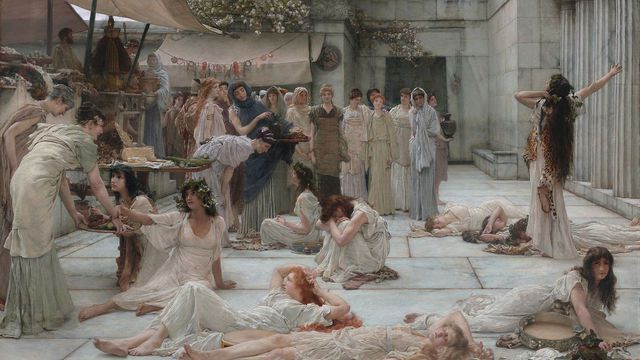
It would be great to experiment with some non-binary dance patterns – breaking away from the tendency to impose hetero-normativity. (People will always manage to flirt according to their personal preferences anyway.) There’s no reason why Maypole ribbon patterns can’t be danced in threes, fives or sevens. It’s not easy to visualise the full consequences of such dances in one’s head – an enthusiastic (and patient) group of volunteers is needed!
May Terpsichore Bless You, May Your Maypoling Delight Her This May!